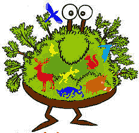Sustainable citiesNow that more than half the human population of the planet lives in cities, garden city and eco-village concepts are feeding into plans for sustainable communities. These are about much more than the environment, including factors such as crime levels, health, transport and employment. Urban greenspace is an important part of the Government's concept of a sustainable community. It will take many forms, from trees along pavements, to parks, community gardens, urban farms and allotments. And it will have many functions, including supporting wildlife, being a focus for community activities, sports, food production and pollution control, as well as supporting general human well-being. Durham county councilDurham county council has produced a set of factsheets and indicators - with the picture (right) as an illustration of the elements that can be included.
|
A sustainable city?In the early 1800s Paris recycled and composted all of its human and animal waste feeding and irrigating 860 hectares of market gardens with heated beds and glasshouses to feed its 2 million inhabitants. 5000 workers were employed on this task, and any excess produce was sold to London. Until just 10 -15 years ago, many Chinese cities operated in a similar way. But rapid industrial expansion in Shanghai and other cities is desroying this sustainable way of life. |
||||||
|
Davies, SacramentoThis city, the first to be designed with permaculture in mind, is planned to stop growing at 50,000 inhabitants. It is a community of people who share the goal of urban sustainability, with close integration of houses, orchards and vegetable Gardens. 20,000 trees shade the houses, which, despite the hot climate, manage without air-conditioning. It has one of the most advanced recycling systems in California. Note the solar panels on the rooves. |
||||||
Good quality parks and open spaces -"...make neighbourhoods, towns and cities attractive and appealing. They are an integral part of the wider public space network and as much a part of the urban fabric as its buildings. "They bring benefits that make places more liveable and sustainable and enrich the quality of people's lives and communities." 'Living Places - Cleaner, Safer, Greener' We are still remaking nature in terms of our own cultural aspirations. But now these include a sense of our place within it, and its place within us. More info: |
|||||||
|
--> home
To commission work of this nature, contact David Thorpe. |
|||||||
 A history of greenspace and parks
A history of greenspace and parks